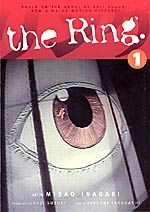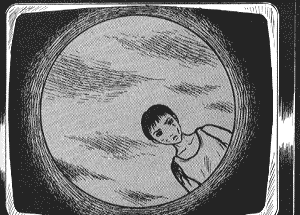 Written by Hiroshi Takahashi
Written by Hiroshi Takahashi
Based on the novel by Koji Suzuki
Art by Misao Inagaki
312 pages, black and white
Published by Dark Horse
I’m not entirely sure why I never saw the movie The Ring. Somehow I managed to miss out on both the original Japanese movie as well as the American remake, probably because I kept telling myself that I’d see one of them “soon”. Thanks to Dark Horse, though, people in the same situation as me now have a third option—the manga written by the screenwriter of the original movie.
A mysterious videotape is out there, one with disturbing images of a well, a young woman, and a warning. Those who see the videotape will die within seven days. When reporter Reiko Asakawa’s niece falls victim to the curse, she is determined to discover what really happened. But will Reiko be able to solve the puzzle of the videotape and its hint on a way to avoid death, or will she be its next victim?
Hiroshi Takahasi’s adaption of Koji Suzuki’s novel (which from what I understand has some pretty dramatic differences between book and script) really surprised me in how quickly the action began. Takahashi plunges into the story, wasting no time at all in getting to what people want to see: the cursed videotape and the struggle to escape certain death. It’s very much to Takahashi’s credit that for what was once a two-volume adaptation (Dark Horse has helpfully printed it all in one book), he’s able to keep the tension quietly building as the clock continues its countdown. Each piece of new information makes the story more intriguing than before, and the final revelations are all but guaranteed to have you jump out of your seat. The Ring is more than a horror story; it’s a story about the bonds of family. Almost every single action in The Ring can be traced back to a family relationship (good or bad), and it’s this very recognizable part of our own lives that lets the horror parts of The Ring hit home so easily.
 The art in The Ring is strong and attractive, with thick ink lines to sharply sketch out its characters. Misao Inagaki’s characters are rooted in the world that you and I live in; there’s almost nothing here that you can’t imagine seeing for yourself. That’s an important quality in a book like this, where half of the fear will come from the reader imagining themselves in the same situation. When The Ring gets to the suspenseful scene inside the well (as well as what happens afterwards), the darkened shadows and sense of dread is expertly drawn by Inagaki. Best of all, Inagaki is good at making what you can’t see just as creepy as what you can. When characters’s faces are hidden, he’s able to draw in a sense of menace in that omission, that somehow it will be far worse than we can imagine. And really, on some level, that’s exactly what happens.
The art in The Ring is strong and attractive, with thick ink lines to sharply sketch out its characters. Misao Inagaki’s characters are rooted in the world that you and I live in; there’s almost nothing here that you can’t imagine seeing for yourself. That’s an important quality in a book like this, where half of the fear will come from the reader imagining themselves in the same situation. When The Ring gets to the suspenseful scene inside the well (as well as what happens afterwards), the darkened shadows and sense of dread is expertly drawn by Inagaki. Best of all, Inagaki is good at making what you can’t see just as creepy as what you can. When characters’s faces are hidden, he’s able to draw in a sense of menace in that omission, that somehow it will be far worse than we can imagine. And really, on some level, that’s exactly what happens.
It turns out just about every movie version of The Ring in Japan (prequels, sequels, strangely-connected not-really-sequels) has been adapted into comics. Now obviously I don’t know how good or bad the others are, but if they’re as strong as The Ring Vol. 1, then we’re in for good times ahead. The Ring Vol. 1 holds up as strong a horror comic as most of the better ones produced on their own in the past couple of years. Now just so long as they don’t make a special comic that kills you seven days after reading it, I’ll be back for more.
Purchase Links:
